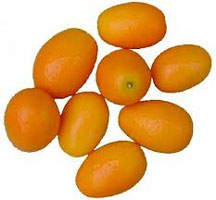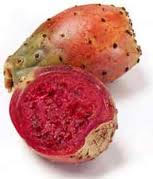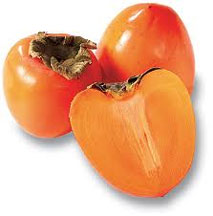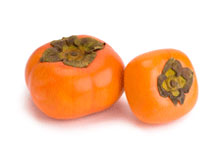Winter Fruit Surprises!
By Alice Osborne
 Oranges, grapefruit, tangerines, pomegranates, and cranberries. We're very familiar with these winter fruits - we see them all the time, especially in the winter. And they're at their peak, flavor- and price-wise right now.
Oranges, grapefruit, tangerines, pomegranates, and cranberries. We're very familiar with these winter fruits - we see them all the time, especially in the winter. And they're at their peak, flavor- and price-wise right now.
But are you as familiar with some of the less common winter fruit? I've always wondered about kumquats, prickly pears, persimmons, and quince. I like to kid around with my hubby and call him my "tender, dimpled kumquat," but I actually have no idea if a kumquat IS tender OR dimpled. And I sure don't know what they taste like or what to do with them.
In my latest copy of Cook's Country (the magazine from the cable TV show, "America's Test Kitchen") I found just what I was looking for on these fun, but uncommon fruit choices. Here's the scoop:
 KUMQUAT is the pygmy of the citrus family - it's about the size of an olive. The entire fruit, from peel to flesh, is edible. In fact, it's actually the rind that's sweet and houses the flavor. The flesh is tart and dry. Kumquats are often candied or pickled. Cook's Country suggests slicing or halving and seeding them before adding them to desserts or baked goods.
KUMQUAT is the pygmy of the citrus family - it's about the size of an olive. The entire fruit, from peel to flesh, is edible. In fact, it's actually the rind that's sweet and houses the flavor. The flesh is tart and dry. Kumquats are often candied or pickled. Cook's Country suggests slicing or halving and seeding them before adding them to desserts or baked goods.
Choose firm kumquats that are bright orange in color; avoid those with a greenish tint. They generally keep at room temperature for up to three days; they can last up to two weeks in the fridge. Kumquats are a good source of fiber, are low in calories, and provide potassium and vitamins A and C.
 PRICKLY PEARS, aka tunas (huh?), are full of crunchy little edible seeds and taste like melon. The fruit is the berry of the prickly pear cactus and is common to the Southwest. If found in grocery stores, they've likely had the spines removed. They're used in making jams and marmalades. The traditional way to eat them is raw - peeled and sliced - with a squeeze of lime.
PRICKLY PEARS, aka tunas (huh?), are full of crunchy little edible seeds and taste like melon. The fruit is the berry of the prickly pear cactus and is common to the Southwest. If found in grocery stores, they've likely had the spines removed. They're used in making jams and marmalades. The traditional way to eat them is raw - peeled and sliced - with a squeeze of lime.
Once they're ripe, they'll store up to 3 days in the refrigerator and up to 12 months in the freezer. Low calorie, fat-free and rich in magnesium (an essential mineral that contributes to the activities of enzymes, promotes healthy heart and kidney function and helps the body produce energy), prickly pear also contains vitamin C, which boosts immunity and provides antioxidant protection against chronic disease. This fruit also contains seventeen amino acids, high fiber content, great levels of vitamin C and bioflavonoids. Impressive, so here's a recipe to get us started:
Prickly Pear Sauce
Yield: about 3 cups(Courtesy of Rick Bayles Mexican Kitchen, Scribner, 1996)
This deep red, bright tasting sauce will liven up anything you put it on. Try it as a sweet accent to savory dishes, like spicy grilled chicken, top off a dessert of poached pears or ice cream with it, or try it on waffles.
2 1/2 pounds (about 16) fresh prickly pears
1/3 cup honey
1 tablespoon fresh lime juice
1 tablespoon orange liqueur (optional)
Trim both ends of the fruit, then make a 1/2-inch deep cut down the side of each one. If the fruit is ripe, the thick rind will easily peel away from the central core. Coarsely chop the peeled fruit, puree in a food processor or blender, then press through a fine strainer into a bowl. There should be about 3 cups.
In a medium-size saucepan, combine 2 cups of the puree with 1/3 cup honey, and simmer rapidly over medium-high heat, stirring frequently, until reduced to 1 cup, then let cool. In a small bowl, stir the uncooked puree with the cooked. Taste and season with lime juice, orange liqueur and additional honey if desired. Store covered in the refrigerator for up to a week, or freeze.

 PERSIMMONS are sweet and creamy and taste like a luscious cross between pumpkin, fresh dates, and plums. YUM! Supermarkets generally carry the acorn-shaped Hachiya and the round Fuyu - both from Asia. The Hachiya must be extremely soft and squishy before you eat it or its tannins will dry out your mouth; the Fuyu can be eaten sliced while firm-tender. North America has a native persimmon as well, but we'll probably never find it in grocery stores today (Cook's Country didn't explain why).
PERSIMMONS are sweet and creamy and taste like a luscious cross between pumpkin, fresh dates, and plums. YUM! Supermarkets generally carry the acorn-shaped Hachiya and the round Fuyu - both from Asia. The Hachiya must be extremely soft and squishy before you eat it or its tannins will dry out your mouth; the Fuyu can be eaten sliced while firm-tender. North America has a native persimmon as well, but we'll probably never find it in grocery stores today (Cook's Country didn't explain why).
Low in calories and fat, high in vitamin C, and a rich source of dietary fiber, persimmons contain many health benefiting phyto-nutrients as well as an important anti-tumor compound, betulinic acid. They're loaded with catechins (an anti-infective, anti-inflammatory and anti-hemorrhagic that prevents bleeding from small blood vessels). Fresh permissions contain anti-oxidant compounds like vitamin-A, beta-carotene, lycopene, lutein, cryptoxanthin, and zeaxanthin (an important dietary carotenoid, selectively absorbed into the retinal macula lutea in the eyes where it provides antioxidant and protective light-filtering functions, preventing age-related macular disease in the elderly).
Persimmons will continue to ripen after they've been harvested. With Hachiyas in fact, you may be better off buying them slightly under-ripe and then finishing them at home, to avoid buying fruit that's been badly bruised. There are those who recommend freezing under-ripe Hachiyas in order to make them edible quickly, but the flavor is never quite as good. Store both varieties at room temperature. Refrigerating them will result in chill damage quite quickly.
 QUINCE, according to Cook's Country, was once commonplace in American kitchens. But no more. Yup - never in my 62 years have I ever seen or tasted one. Although fragrant, it's hard, dry, and astringent when raw. But it's amazingly delicious when cooked. Peel and poach for tarts or compotes; roast to serve alongside meats; or add a few slices to your next apple pie. Thanks to loads of pectin (a natural thickener) quince is also ideal for jams, jellies, and preserves.
QUINCE, according to Cook's Country, was once commonplace in American kitchens. But no more. Yup - never in my 62 years have I ever seen or tasted one. Although fragrant, it's hard, dry, and astringent when raw. But it's amazingly delicious when cooked. Peel and poach for tarts or compotes; roast to serve alongside meats; or add a few slices to your next apple pie. Thanks to loads of pectin (a natural thickener) quince is also ideal for jams, jellies, and preserves.
Choose very firm golden-yellow fruits with a sweet, heavy fragrance. Avoid those that are wrinkled or greenish. Keep at room temperature, in a single layer for up to one week, or refrigerate in a sealed plastic bag for up to two months. Keep away from other fruits.


